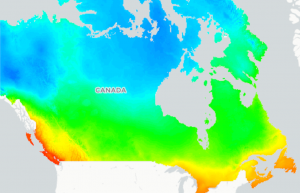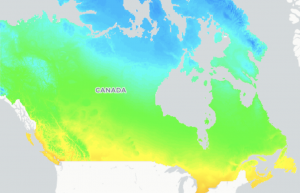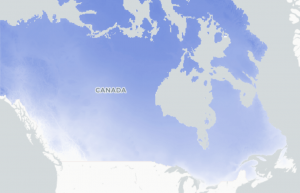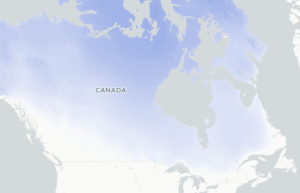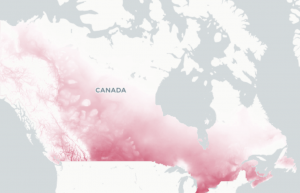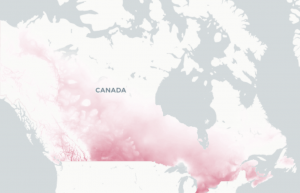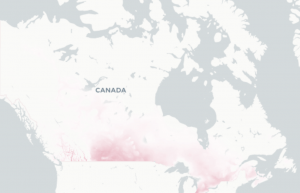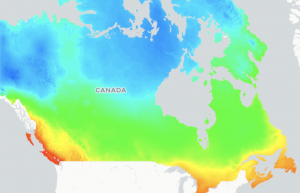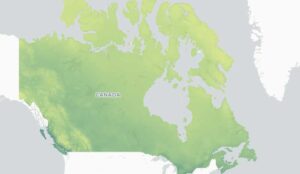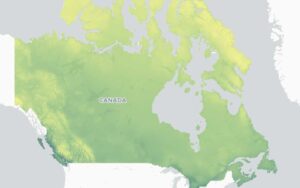Days with Max Humidex > 30 describes the number of days where the Humidex is greater than 30. This index gives an indication of the number of hot and humid days in the selected time period.
The Humidex was developed by the Meteorological Service of Canada to describe how hot and humid the weather feels to the average person. In Canada, it is recommended that outdoor activities be moderated when the Humidex exceeds 30, and that all unnecessary activities cease when it passes 40 (Environment and Climate Change Canada, 2019).
The number of days with a maximum Humidex (HX) over 30.
Use the Variable menu option to view annual, monthly or seasonal values for this index.
Humidex projections (developed by Environment and Climate Change Canada)
Humidex combines the temperature and humidity into one number to reflect the perceived temperature. Because it takes into account the two most important factors that affect summer comfort, it can be a better measure of how the weather affects the human body than either temperature or humidity alone.
Humidex is widely used in Canada. In the past, extremely high values were rare except in the southern regions of Ontario, Manitoba and Quebec, as well as southern sections of Alberta and Saskatchewan. Generally, the Humidex decreases as latitude increases.
Projections are available at a resolution of 0.1° (approximately 9 km) from 1950-2100.
Scenario and model uncertainty
Uncertainty in the amount of greenhouse gases that will be emitted over the coming century is represented by providing results for multiple emissions scenarios (SSP1-26, SSP2-45 and SSP5-85). Climate model uncertainty is represented by providing the 10th, 50th, and 90th percentile of results across a 19-member model ensemble (see below for the full list).
Methods
Following the results of Diaconescu et al. (2022), daily maximum temperature and daily minimum relative humidity from CMIP6 GCMs were statistically downscaled and bias corrected using the N-dimensional probability density function transform multivariate quantile mapping method (Cannon, 2018) against ERA5-Land (Muñoz, 2019) hourly temperature and relative humidity at the time of daily maximum Humidex. The bias-corrected temperature and relative humidity values were next used in the following equations to compute daily maximum Humidex:
\text{Humidex} = T_a + \frac{5}{9}(\rho - 10) \\
\text{Where:} \\
\rho = 6.112 x 10^{7.5*T_a/(237.7+T_a)}*\text{RH}/100, \\
T_a = \text{air temperature (°C)}, \\
RH = \text{relative humidity}
References
Cannon, A. J. (2018). ‘Multivariate quantile mapping bias correction: an N-dimensional probability density function transform for climate model simulations of multiple variables’, Climate Dynamics, 50(1-2), 31-49. Available at https://doi.org/10.1007/s00382-017-3580-6
Diaconescu, E. P. et al. (2022) ‘A short note on the use of daily climate data to calculate Humidex heat-stress indices’, International Journal of Climatology, 1– 13. https://doi.org/10.1002/joc.7833
Environment and Climate Change Canada. (2019) Warm Season Weather Hazards.
Muñoz Sabater, J., 2019: ERA5-Land hourly data from 1981 to present. Copernicus Climate Change Service (C3S) Climate Data Store (CDS).
List of models
| Institution |
Model name |
Realization |
| CSIRO-ARCCSS (Australia) |
ACCESS-CM2 |
r1i1p1f1 |
| CSIRO (Australia) |
ACCESS-ESM1-5 |
r1i1p1f1 |
| CNRM-CERFACS (France) |
CNRM-CM6-1 |
r1i1p1f2 |
| CNRM-CERFACS (France) |
CNRM-ESM2-1 |
r1i1p1f2 |
| CCCma (Canada) |
CanESM5 |
r1i1p1f1 |
| CMCC (Italy) |
CMCC-ESM2 |
r1i1p1f1 |
| EC-Earth-Consortium (Europe) |
EC-Earth3 |
r1i1p1f1 |
| EC-Earth-Consortium (Europe) |
EC-Earth3-Veg |
r1i1p1f1 |
| EC-Earth-Consortium (Europe) |
EC-Earth3-Veg-LR |
r1i1p1f1 |
| CAS (China) |
FGOALS-g3 |
r1i1p1f1 |
| NASA-GISS (USA) |
GISS-E2-1-G |
r1i1p1f2 |
| INM (Russia) |
INM-CM4-8 |
r1i1p1f1 |
| INM (Russia) |
INM-CM5-0 |
r1i1p1f1 |
| IPSL (France) |
IPSL-CM6A-LR |
r1i1p1f1 |
| MIROC (Japan) |
MIROC-ES2L |
r1i1p1f2 |
| MIROC (Japan) |
MIROC6 |
r1i1p1f1 |
| DKRZ (Germany) |
MPI-ESM1-2-HR |
r1i1p1f1 |
| MPI-M (Germany) |
MPI-ESM1-2-LR |
r1i1p1f1 |
| MRI (Japan) |
MRI-ESM2-0 |
r1i1p1f1 |



